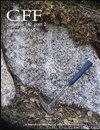Stable carbon and oxygen isotope geochemistry as provenance indicator for the picture stones on Gotland (Sweden)
IF 1.2
4区 地球科学
Q2 GEOLOGY
引用次数: 0
Abstract
ABSTRACT The picture stones from Gotland are one of the most famous and exceptional groups of monuments known from Swedish Prehistory. These carved memorial stones and their extraordinarily rich imagery are a unique source for the study of Late Iron and Viking Age culture and in particular Scandinavian pre-Christian religions. The Gotlandic picture stones are mainly made from the thickly layered limestones surrounding the reefs and bioherms of Gotland’s carbonate platform from the middle part of the Silurian (latest Llandovery to Ludlow, Telychian – Ludfordian). However, the exact origins of the picture stones’ raw materials on Gotland have remained undetermined. In this paper, we investigate the geological origin of the raw material by isotope geochemistry. Whereas the oxygen (δ18O) and strontium isotope ratio (87Sr/86Sr) were strongly altered by diagenesis the carbon isotope ratio (δ13C) is quite stable. Because the different geological units on Gotland show specific isotope signatures, the δ13C values from picture stones can be used to assign them to the respective geological unit, and thus to the source area of the raw material. This also allows for an estimation of transport distance minima between the raw material source area and the find place of each sampled picture stone. Most of the picture stones seem to be produced from local material with short transport distances, less than 10 km and only a few were transported at a far distance exceeding 10 km. In summary, the transport distance was dependent mostly on the local availability of picture-stone-suitable rocks.稳定碳、氧同位素地球化学作为瑞典哥特兰画像石的物源指示
本文章由计算机程序翻译,如有差异,请以英文原文为准。
求助全文
约1分钟内获得全文
求助全文
来源期刊

Gff
地学-地质学
CiteScore
2.80
自引率
10.00%
发文量
11
审稿时长
>12 weeks
期刊介绍:
GFF is the journal of the Geological Society of Sweden. It is an international scientific journal that publishes papers in English covering the whole field of geology and palaeontology, i.e. petrology, mineralogy, stratigraphy, systematic palaeontology, palaeogeography, historical geology and Quaternary geology. Systematic descriptions of fossils, minerals and rocks are an important part of GFF''s publishing record. Papers on regional or local geology should deal with Balto-Scandian or Northern European geology, or with geologically related areas. Papers on geophysics, geochemistry, biogeochemistry, climatology and hydrology should have a geological context. Descriptions of new methods (analytical, instrumental or numerical), should be relevant to the broad scope of the journal. Review articles are welcome, and may be solicited occasionally. Thematic issues are also possible.
 求助内容:
求助内容: 应助结果提醒方式:
应助结果提醒方式:


